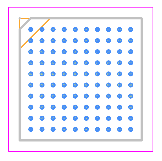EPM570F100I5N CPLDs: Features, Applications and Datasheet
2025-03-13 09:59:24 1552
EPM570F100I5N Description
The EPM570F100I5N is a high-performance Complex Programmable Logic Device (CPLD) from Intel's (formerly Altera) MAX II series. Designed for low-power, high-speed applications, it offers 570 logic elements (LEs) and 100-pin Fine-Pitch Ball Grid Array (FBGA) packaging, making it suitable for various embedded system designs that require flexible logic implementation.
EPM570F100I5N Features
Logic Elements (LEs): 570
Operating Voltage: 3.3V core with 1.8V to 3.3V I/O compatibility
Low Power Consumption: Based on Flash-based architecture, providing instant-on performance with minimal power requirements
Fast Propagation Delay: Optimized for high-speed signal processing
100-Pin FBGA Package: Provides compact design with high pin density
Non-Volatile Memory: Configuration is retained even after power-down
JTAG Support: Integrated JTAG boundary scan for easy programming and debugging
Multiple Clock Management: Offers multiple clock domains for enhanced timing performance
EPM570F100I5N Applications
The EPM570F100I5N is widely used in the following fields:
Embedded System Control: Acts as a customizable logic controller for industrial and consumer applications
Data Communication & Networking: Used in protocol conversion, signal interfacing, and high-speed switching
Automotive Electronics: Implements real-time logic processing for ADAS, infotainment, and in-vehicle networking
Medical Equipment: Helps in data acquisition, signal filtering, and control systems
Aerospace & Defense: Used for secure signal processing and fault-tolerant logic control
Industrial Automation: Enables programmable logic sequencing and machine control
EPM570F100I5N CAD Model
Symbol

Footprint

3D Model


EPM570F100I5N Alternatives
If the EPM570F100I5N is unavailable, the following CPLDs/low-end FPGAs can be considered as
alternatives:
EPM7128SLC84-10 (Altera MAX 7000 Series) – Offers similar logic capabilities with higher power consumption
XC9572XL-100TQG100C (Xilinx CPLD) – Comparable in power efficiency and pin count but with different architecture
Lattice LC4256V-75TN100C (Lattice ispMACH 4000 Series) – Higher logic density but requires different toolchains
ATF1508AS-10JU100 (Microchip CPLD) – Good for simple logic applications but lower density
ICE40LP1K-CM121 (Lattice FPGA) – Ultra-low power FPGA alternative for power-sensitive applications
EPM570F100I5N Manufacturer
Intel Corporation, founded in 1968 and headquartered in Santa Clara, California, USA, is a global leader in semiconductor technology, known for its microprocessors, chipsets, storage solutions, FPGAs, and AI accelerators. As one of the world's largest chip manufacturers, Intel’s innovations are widely used in personal computing, data centers, artificial intelligence (AI), the Internet of Things (IoT), and automotive electronics.
Intel's core business spans microprocessors (Core™ and Xeon®), data center and cloud computing, AI acceleration, FPGAs and programmable logic devices (Agilex™, Stratix™), embedded systems, graphics processing (Intel Arc™), and automotive computing (Mobileye). As a pioneer of Moore’s Law, Intel continuously advances semiconductor manufacturing with cutting-edge process nodes such as Intel 7, Intel 4, Intel 3, and Intel 20A, integrating breakthrough technologies like RibbonFET and PowerVia to enhance computing performance and energy efficiency.
Amid fierce competition with AMD, NVIDIA, TSMC, and Qualcomm, Intel is expanding its manufacturing footprint across the U.S., Europe, and Asia to strengthen global chip supply chains. As a driving force behind AI, quantum computing, and edge computing, Intel plays a crucial role in global technological innovation and digital transformation.
EPM570F100I5N FAQs
How does the EPM570F100I5N handle asynchronous clock domains?
The EPM570F100I5N allows for multiple asynchronous clock domains but lacks built-in PLLs. For stable multi-clock operation, external clock synchronization techniques such as double flip-flop synchronization or handshaking signals are recommended.
What is the maximum toggle frequency of the logic elements in this CPLD?
The maximum toggle frequency for the internal logic elements can reach over 300 MHz, but this depends on signal fan-out, routing delays, and power constraints.
Can EPM570F100I5N be used for soft microcontroller implementation?
Yes, while it is a CPLD and not an FPGA, it is possible to implement a basic soft microcontroller using state machines and control logic, although it lacks the resources for advanced RISC-V or ARM cores.
How does the flash-based architecture affect power-up time?
Unlike SRAM-based FPGAs, the flash-based architecture of the EPM570F100I5N provides an instant-on feature, meaning it retains its configuration and boots immediately when powered up, eliminating the need for external configuration memory.
What is the maximum power dissipation under full load?
Under full logic utilization and high toggle rates, the maximum power dissipation can reach approximately 250–300 mW, but in typical conditions, it remains below 150 mW, making it highly efficient for battery-powered applications.




